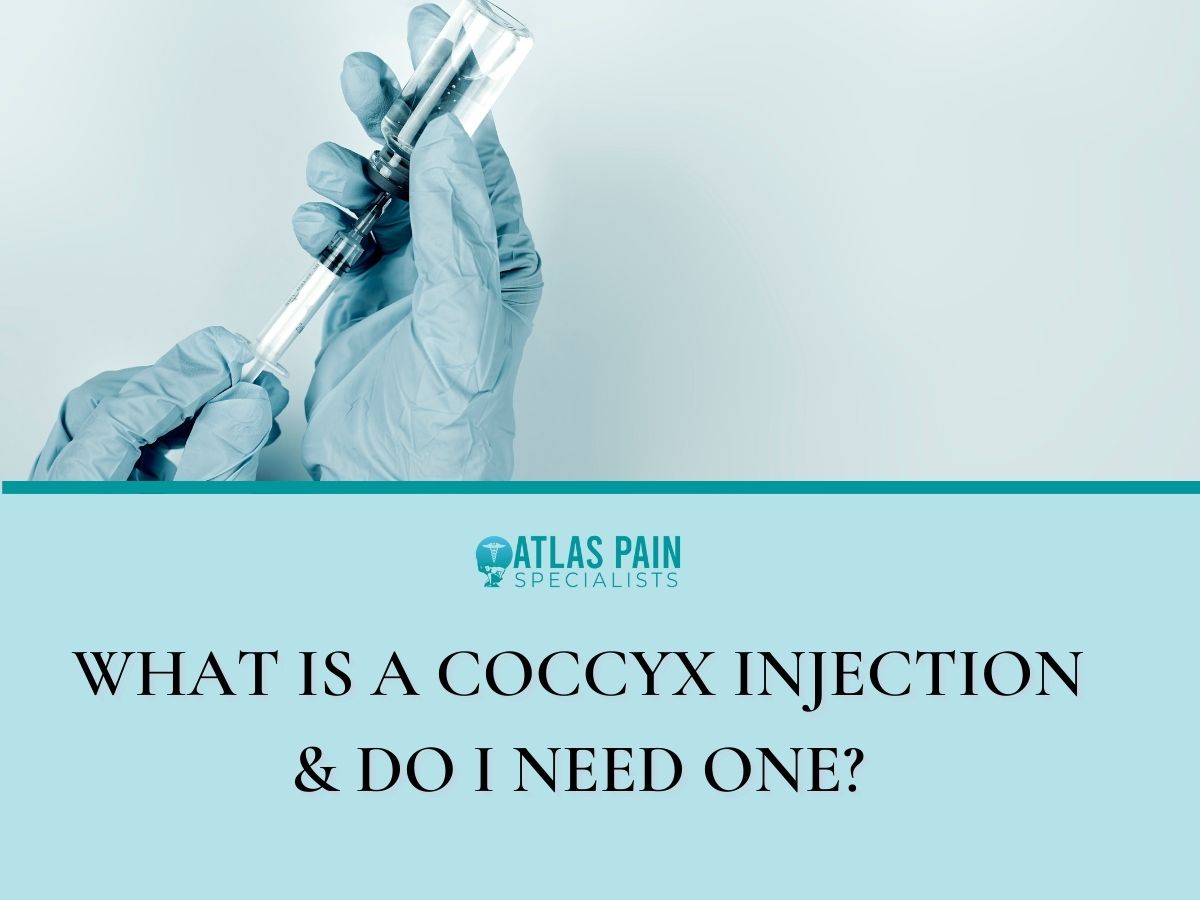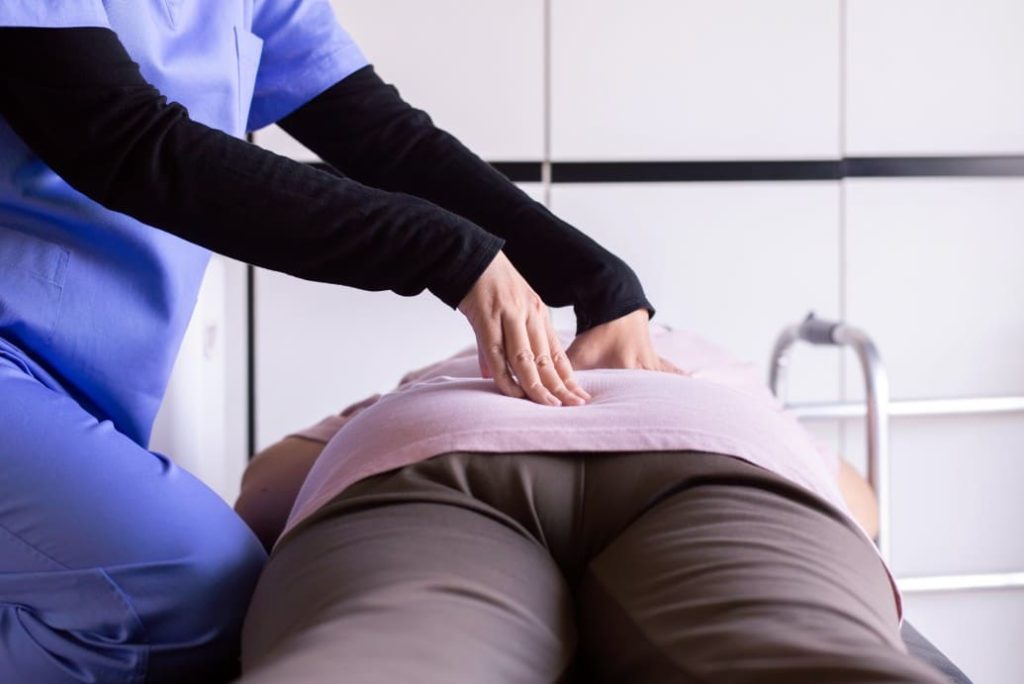

What Is A Coccyx Injection & Do I Need One?
The coccyx is the smallest bone at the posterior (your back) at the bottom of the spinal column. It anchors multiple muscles in the pelvic area and bears the body's weight when a person is sitting. Otherwise known as your tailbone.
As a result, the coccyx is an integral part of human anatomy. Individuals who experience persistent pain in the coccyx may benefit from a coccyx injection procedure.
Coccydynia
Coccygodynia (tailbone pain) is another term for this condition. This is coccyx-related pain. It may occur due to an injury or strain to the coccyx or the surrounding ligaments and muscles.
Tailbone pain can be challenging to treat because various factors can cause it. The majority of cases resolve within a few weeks or months, but the pain can become chronic for a small number of people.

About 1/3 of the causes are unknown. There are 3 types of scenarios that cause coccydynia:
- External Trauma: such as an accident
- Internal Trauma: for example, sitting on uncomfortable surfaces for prolonged periods
- Other: tumors, infections, or abscesses
What Can Cause Coccydynia?
An external or internal trauma can be the cause of tailbone pain. Here is some example:
- Accidents
- Bad Posture (or just sitting)
- Child Birth (difficult delivery)
- Hypomobility or hypermobility
- Extreme Weight loss (less likely)
- Being overweight
- RSI (repetitive strain injury)
Accidents
A backward fall or automobile accident may bruise, break, or dislocate the coccyx. This can be extremely painful!
Sitting
Sitting on an uncomfortable surface for an extended period or repeatedly can result in minor trauma.
Weightloss
With extreme weight loss, it is possible to develop this ailment due to the significant loss of cushioning and padding of the area.
Childbirth
Internal trauma can occur during childbirth, especially if the delivery is difficult.
Non-traumatic coccydynia can occur due to hypomobility or hypermobility of the sacrococcygeal joint. With hypermobility, you are getting too much movement and in hypomobility, your movement is getting restricted.
Obesity
Obesity can cause coccydynia because of the added pressure the weight is exerting on your tailbone area.
RSI
A repetitive strain injury is usually caused by sports that put extra pressure on your coccyx, road biking is a good example. You are in a low forward position while sitting on a hard narrow seat.
Coccyx Injection
It has been established that a combination of the ganglion of impar block and coccygeal nerve block is a successful treatment for coccyx pain.
Although they commonly treat back pain, caudal epidural injections can also treat coccyx pain.
Although most injections are not the first line of treatment for tailbone pain, they provide significant pain relief for patients diagnosed with the condition.
An anesthetic is injected into the injection site, which is thoroughly cleaned before being numbed with a local anesthetic. Fluoroscopy (live X-ray) is then used to guide the needle to the injection site to prevent complications such as organ, nerve, tissue, or blood vessel damage.
Depending on the severity of the case, a sedative may be administered.
The procedure is an outpatient procedure, and the patient can usually be discharged within an hour of completion. It takes approximately 30 minutes to complete, so there is no need for a recovery period as with surgery.
- Ganglion impar block
A ganglion is an area of intersection of nerves in the body. Nerves relaying information to the brain pass through the ganglion impar.
Pain relief is achieved by blocking the nociceptive and sympathetic nerve fibers.
A needle-in-needle injection technique is commonly used for injections, with minimal risks compared to the bent needles used in the past.
The needle is placed under live fluoroscopic guidance and passed through the sacrococcygeal opening, whereby various safety measures are taken to ensure the safe delivery of the needle to the injection site.
This nerve block is sometimes administered with a steroid injection, where the nerve block treats nerve pain while the steroid helps treat musculoskeletal pain or inflammation. Patients receive up to 50-60% pain relief with repeat injections. The relief can last up to a few weeks to several years.
- Coccygeal injection
This procedure involves the injection of steroids and a local anesthetic into the injured area to alleviate the pain.
The injection is administered in the specific area of the patient's body that corresponds to their diagnosis.
The injection is targeted at the specific area of discomfort. For example, if the pain appears to be coming from a hyper-mobile or coccyx bone spur, an injection will be administered to that specific area.
This demonstrates how critical it is to make an accurate diagnosis during this procedure to avoid mistakes in identifying the source of pain or administering the injection to the incorrect area.
- Caudal Epidural Injection
The epidural space is a space that surrounds the nerves that run down the spine and into the legs. If the nerves are inflamed, it is likely to cause lower back pain.
An acaudal epidural injection is a procedure that involves the administration of an anesthetic and a steroid to the lower back to reduce pain and inflammation, respectively. It can treat chronic coccyx pain in both the short and long run.
The procedure is completed in less than an hour and has a high success rate compared to surgical intervention.
The procedure is effective in most patients, but some may require additional injections over a period determined by the physician. This can happen up to three times per year.
Post-treatment
Despite the procedure taking between 15 and 30 minutes to finish, get someone to drive you home because it is dangerous to do so yourself. Avoid engaging in strenuous physical activity after the injection.

You may experience some discomfort after the injection, especially headaches and injection site pain. The patient may experience increased pain for a few days because the numbing medication gradually wears off.
Numbness in the legs may also be experienced due to the pooling of the numbing medicine in the sacrum. This may make it affect some nerves more than others.
Actual pain relief occurs 2-3 days after the injection, but this may take longer for some people, taking up to 10 days. You can resume physical activities after a day but gradually increase the amount of work you do over some time instead of doing it all at once.
Side effects and complications
Medicine can be defined as anything foreign, natural, or manufactured, altering how the body functions. Most of the time, these changes come with varying levels and periods of side effects and complications.
Common side effects after a coccyx injection may be:
- Pain at the injection site
- Swelling or soreness around the injection site
- Headache
- Nausea
- Dizziness
- Facial flushing
- Mild abdominal cramps
Some diabetes patients have also reported changes in their blood sugar levels due to the steroid injection. Some women have also reported a temporary alteration in the pattern of their menstrual cycle.
If you are allergic to any medication or steroid, you must notify your doctor before having the procedure performed on you. This is done to prevent allergic reactions during or after the injection.
Serious side effects from the injection are possible, although they are rare. In the past, when a bent or curved needle was used for the procedure, complications were a common occurrence.
- Rectal perforation
The colon is composed of layers of mucous membranes and smooth muscles. Due to its proximity to the coccyx, rectal perforation may occur if the needle makes a hole in the layer.
This causes the bowel contents to spill out into the nearby tissues.
- Hemorrhage
Injection site hemorrhage may occur, but it can get serious if an artery or vein is punctured during the procedure. This may lead to internal bleeding and even clotting in the arteries, blocking blood flow to other body parts.
- Infection
Infection of the injection site may occur primarily due to microbes on the patient’s skin. The injection site should be sterilized before the injection is done.
Internal infection may also occur in the soft tissue, causing a soft tissue abscess—this accumulation of pus in the soft tissue around the injection site.
- Dural puncture
When a lumbar epidural injection is used as the pain relief method, the needle may puncture the membranes of the spinal column (meninges), causing the cerebrospinal fluid to spill out into the surrounding tissue.
This may decrease cerebrospinal fluid pressure, which causes dizziness, headaches, or migraines.
Traditional pain management alternatives
The physician may recommend alternative (stem cell therapy and PRP therapies are good examples) and home therapies for pain relief after the coccyx injection or even in place of the coccyx therapy. Some of these are:
- Physical therapy
Exercises that gradually increase the patient's mobility may help them move more freely. Stretches and physical activities are included, and the results of these tests confirm the effectiveness of the treatment.
This may be uncomfortable at first, but it should be relatively straightforward each time if the treatment is effective. It is essential to consult your doctor if there is any secondary pain following the injection.
- Hot and cold therapy
Cold therapy includes the application of an ice pack to the injection site to reduce swelling. This is accomplished through vasoconstriction, which reduces blood flow to the swollen area, preventing tissue damage.
It is also a topical anesthetic that provides pain relief to the patient. It has been shown to reduce nerve activity in the area, reducing pain signals to the brain.
The application of hot water to the injured area is accomplished by using a towel massage or a hot water bag. As a result, increased blood flow through vasodilation and the relaxation of tightened muscles around the area.
Heat therapy should be avoided entirely for new wounds or swollen areas. It causes an increase in blood flow and nerve stimulation in the affected area, which results in increased pain.
Both hot and cold therapies may be employed to provide comfort for the patient.
- Massage therapy
Injury to the coccyx may make some activities difficult to do. You may find it hard to do activities involving the lower back, such as pain while standing or sitting down.
A massage of the lower back and hips may help reduce the pain. This may be combined with physical therapy such as hip flexing vertically and horizontally.

Neurostimulation therapy
This is a relatively new form of treatment where radio frequencies are used to modulate the function of the nerve. The pain signals are modified, so the same pain as before isn’t felt.
We could say that the pain is outsmarted in this situation. This type of treatment has several advantages, including providing personalized pain management. The procedure enables a patient to try out therapy for a short period before committing to a permanent implant procedure.
As the patient goes about their day, engaging in various activities, the treatment can be adjusted to provide different levels of stimulation to keep them engaged.
This type of treatment includes Dorsal Root Ganglion (DRG) therapy, and you can make an appointment with us at Atlas Pain Specialists to receive it.
Frequently Asked Questions
Can pregnant women get a coccyx injection?
No, pregnant women aren’t advised to get a coccyx injection because an x-ray is used as one of the diagnosis and procedural methods. This may harm the fetus.
Can nerve ablation treat coccyx pain?
Nerve ablation is the deliberate destruction of nerves to reduce tailbone pain. The idea is that if the nerves transmitting the pain signals aren’t functional, there will be no pain.
This is done if other forms of treatment and injections don’t reduce the pain and are often one of the last pain relief options.
How is nerve ablation of the coccyx done?
There are various ways in which the nerves can be killed for pain relief.
Chemical ablation: chemicals like alcohol and phenol are used. This is often the preferred method.
RFA (Radio Frequency Ablation): This method uses radio frequencies to heat up the nerves beyond their functioning point.
Cryoablation: This method uses cold methods like freezing the nerves to kill them.
Should I get injection therapy?
The answer is it depends! Each case is different in severity but if you are in pain then injection therapy is worth it. however, a lifestyle change is also a strong recommendation to combat your pain!
How can I receive a coccyx injection?
Book an appointment or visit us at Atlas Pain Specialists today! We will give you a complete diagnosis based on your medical records and current pain state. This will, in turn, help us help you choose the best treatment plan for pain relief.
About Dr. Sean Ormond



